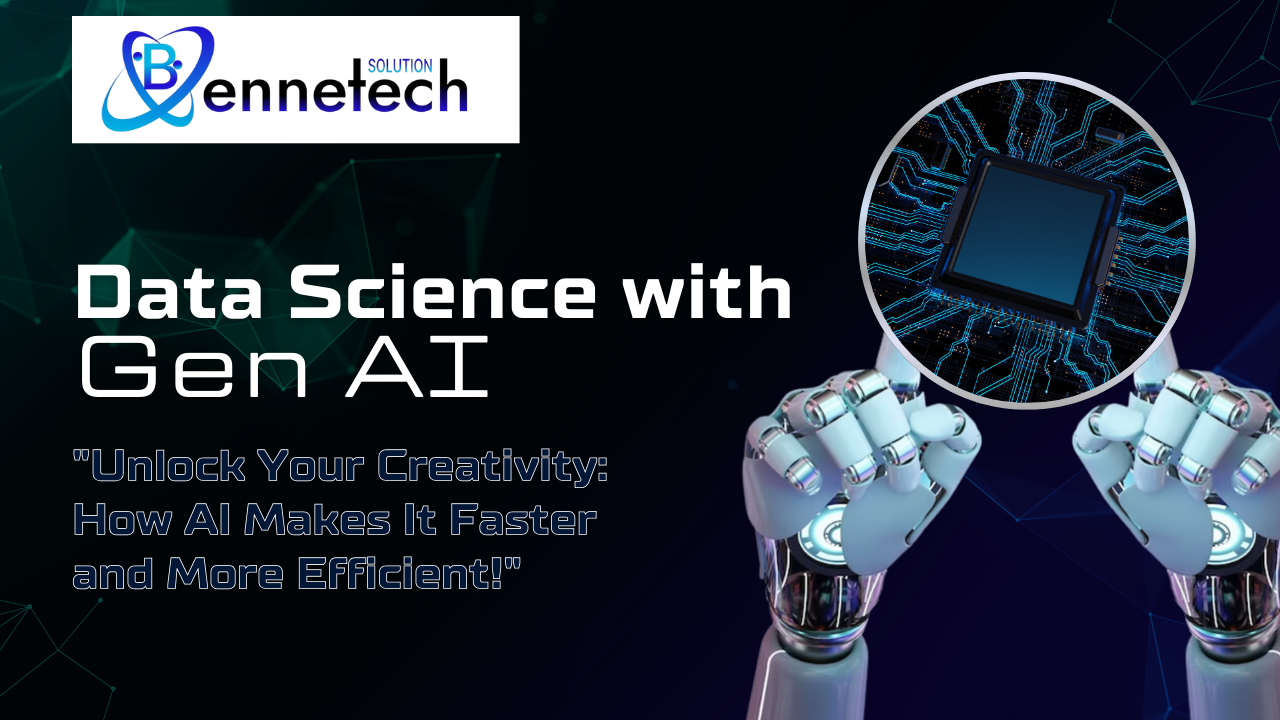Master Data Science with Generative AI

About Course
The “Data Science with Generative AI” course is a comprehensive and future-focused training program designed to bridge the gap between data analysis, machine learning, and the revolutionary capabilities of Generative Artificial Intelligence. As we advance into an era where AI is not just interpreting data but also creating new content, the need for data scientists proficient in generative models is at an all-time high. This course aims to equip students, professionals, and tech enthusiasts with in-demand skills that blend traditional data science methodologies with the latest in AI innovation.
Who is This Course For?
-
Students and graduates looking to build a career in AI and Data Science.
-
IT professionals looking to transition into AI-focused roles.
-
Entrepreneurs and startup founders exploring data-driven innovation.
-
Researchers and data analysts who want to enhance their skills with cutting-edge AI tools.
Key Modules and Subjects Covered
1. Foundations of Data Science
-
Introduction to Data Science and its Applications
-
Python Programming for Data Analysis
-
Data Wrangling and Cleaning with Pandas & NumPy
-
Data Visualization using Matplotlib, Seaborn, and Plotly
-
Statistical Foundations and Probability
2. Machine Learning Essentials
-
Supervised vs. Unsupervised Learning
-
Regression and Classification Algorithms
-
Decision Trees, Random Forests, KNN, SVM
-
Model Evaluation and Optimization
-
Introduction to Scikit-Learn and TensorFlow
3. Deep Learning Fundamentals
-
Introduction to Neural Networks
-
Backpropagation and Activation Functions
-
Convolutional Neural Networks (CNNs)
-
Recurrent Neural Networks (RNNs) and LSTM
-
Model Deployment using Flask and FastAPI
4. Introduction to Generative AI
-
What is Generative AI?
-
Overview of GANs (Generative Adversarial Networks)
-
Variational Autoencoders (VAE)
-
Diffusion Models and Text-to-Image AI
-
Transformer Architecture and Attention Mechanisms
5. Hands-On with Generative Models
-
Building your first GAN using TensorFlow and PyTorch
-
Training a model to generate synthetic images
-
Text Generation using GPT and LLaMA models
-
Fine-tuning pre-trained generative models
-
Ethical concerns and deepfake detection
6. Natural Language Processing (NLP) with Generative AI
-
Tokenization, Lemmatization, and Word Embeddings
-
Transformer-based models (BERT, GPT, T5)
-
Chatbot Development using LLMs
-
Prompt Engineering and Zero-shot Learning
-
Building AI for summarization, translation, and Q&A systems
7. Real-World Projects and Case Studies
-
AI-based Data Augmentation for Training Sets
-
Predictive Analytics in Finance and Healthcare
-
Generative Design in Manufacturing
-
Personalized Marketing using AI-generated Content
-
Synthetic Data Creation for Privacy Preservation
Benefits of the Course
✅ Industry-Relevant Skills
The course is designed in collaboration with global tech leaders and US universities to ensure alignment with current industry needs. You’ll learn the tools, frameworks, and methodologies that top data scientists and AI engineers use today.
✅ Practical, Hands-on Learning
You won’t just learn theory—you’ll build, test, and deploy real projects. Our labs and capstone projects simulate real-life scenarios, making you job-ready.
✅ Certification from a Reputed US University
Stand out in the competitive job market with a certificate backed by academic credibility and international recognition.
✅ Expert Mentors and Career Guidance
Learn from AI researchers, data scientists, and tech entrepreneurs. Get mentorship on how to build a career, ace interviews, and become an AI thought leader.
✅ Community and Networking
Join an alumni network of thousands of professionals and collaborate on projects, job referrals, and innovation.
Future Scope and Global Market Demand
🌐 Exploding Demand for Generative AI Experts
With the rapid adoption of ChatGPT, Midjourney, and other generative tools, companies worldwide are on a hiring spree for individuals who understand both data science and content generation.
-
According to McKinsey, generative AI could add $4.4 trillion to the global economy annually.
-
LinkedIn and Indeed list “Generative AI Specialist” and “AI Prompt Engineer” among the fastest-growing job titles.
💼 Career Opportunities Include:
-
Data Scientist
-
Generative AI Engineer
-
Machine Learning Engineer
-
AI Researcher
-
NLP Engineer
-
AI Product Manager
-
Deep Learning Specialist
📈 High-Paying Global Roles
Companies like Google, OpenAI, Microsoft, Meta, and Adobe are investing billions into generative AI. Talented professionals in this space command six-figure salaries even at entry and mid-level roles, especially in the US, UK, Canada, India, and Europe.
🧠 Beyond Jobs – AI for Innovation
Whether it’s creating art, writing code, generating reports, or designing virtual worlds—Generative AI opens endless doors for entrepreneurs, creatives, and tech leaders.
Course Content
Basics of Mathematics for Data Science
Student Ratings & Reviews

